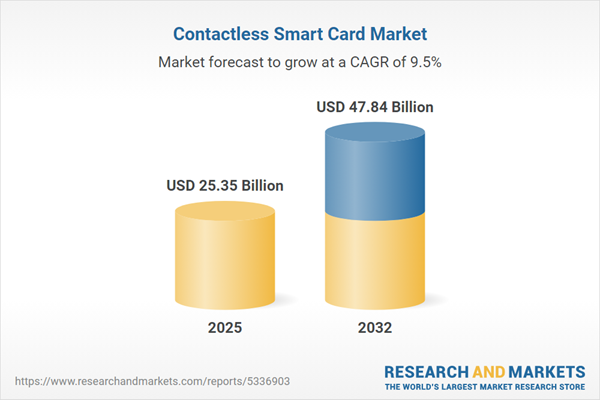Speak directly to the analyst to clarify any post sales queries you may have.
Contactless smart cards are transforming how enterprises manage identity and access control, providing secure, compliance-ready solutions necessary for operating in dynamic risk environments. These credentialing technologies help leaders safeguard assets, streamline workflows, and respond proactively to evolving regulatory and operational mandates.
Market Snapshot: Outlook and Growth Drivers for the Contactless Smart Card Market
The global contactless smart card market is projected to grow from USD 23.20 billion in 2024 to USD 25.35 billion in 2025, reaching USD 47.84 billion by 2032, fueled by a compound annual growth rate (CAGR) of 9.46%. This robust expansion is driven by enterprise demand for reliable authentication, heightened investment in digital infrastructure, and continual adaptation to emerging compliance requirements. Sectors such as banking, government, healthcare, retail, and transportation are adopting these technologies to enhance operational efficiency. As organizations seek to improve user experience and protect sensitive data, industry vendors accelerate innovation and forge strategic collaborations to enable more interoperable, scalable platforms.
Scope & Segmentation of the Contactless Smart Card Market
- Applications: Workforce identification, secure payments, employee onboarding, event management, personal identity verification, and transit ticketing depend on smart card solutions. These uses offer tamper-resistant credentials tailored to mission-critical workflows, helping enterprises mitigate fraud risks and standardize authentication across departments.
- Card Types: Dual-interface, hybrid, memory-only, and microprocessor-enabled smart cards enable organizations to customize access strategies based on targeted compliance needs and distinct operational challenges.
- Technology Standards: Adherence to ISO 14443A/B, ISO 15693, and NFC standards ensures seamless, secure data exchanges between systems, supporting interoperability across broad industry ecosystems.
- End Users: Financial institutions, government agencies, healthcare providers, retailers, and transport operators alike leverage these platforms to simplify compliance management and ensure secure physical and digital access across facilities.
- Form Factors: Standard cards, wearable technology, self-adhesive tokens, and key fobs promote flexible credential deployment for both stationary and mobile use cases, increasing accessibility throughout the workforce.
- Geographies: Widespread adoption is observed in the Americas, Europe, Middle East, Africa, and Asia-Pacific regions. Asia-Pacific prioritizes digital payment infrastructure and high-volume mass transit implementations, while Americas and Europe emphasize alignment with evolving regulatory standards and government-led projects.
- Leading Companies: Industry leaders include NXP Semiconductors, Infineon Technologies, STMicroelectronics, Samsung, Thales, IDEMIA, Giesecke+Devrient, HID Global, LEGIC, and Eastcompeace. These companies underpin broad technology rollouts with adaptable, secure solutions to meet unique enterprise specifications.
Key Takeaways: Strategic Insights for Senior Decision-Makers
- Integrating both physical and digital credentials builds a more resilient security architecture while simplifying identity management throughout the organization.
- Emphasizing solutions built on open standards positions enterprises for quicker adaptation to regulatory changes and enhances long-term compliance assurance.
- Selecting multiple card formats across business units offers operational agility, enabling seamless process adaptation if requirements or governance frameworks change.
- Biometric functionality such as fingerprint authentication augments data privacy for critical workflows and introduces another layer of protection for sensitive roles.
- Regional deployment priorities differ, with Asian markets leading digital payment and transit advances, while Europe and the Americas align efforts with public sector mandates and compliance obligations.
- Active partnerships with technology providers and industry standards groups strengthen supply chain visibility and support robust, future-ready deployments.
Tariff Impact: Navigating Shifts in the Contactless Smart Card Market
Projected changes to U.S. tariffs in 2025 encourage manufacturers to enhance domestic production capacity and establish new partnerships in emerging regions. In response, enterprises in sectors like financial services and transportation are updating their sourcing and procurement strategies to include greater supplier diversity and local sourcing. This minimizes exposure to global disruptions and reinforces supply chain stability as market conditions evolve.
Methodology & Data Sources
This assessment is grounded in rigorous secondary research, direct interviews with industry executives, and thorough data triangulation. Engagement from subject-matter experts ensures each insight remains relevant for enterprise planning, supports informed technology investment, and reinforces practical risk management.
Why This Report Matters
- Equips senior leaders with actionable guidance to strengthen authentication frameworks and mitigate security risks at scale.
- Delivers segment-specific intelligence to support digital transformation and seamless compliance with complex regulatory structures.
- Serves as a trusted resource for designing futureproof credentialing systems that flexibly address changing organizational requirements.
Conclusion
Contactless smart card solutions enable organizations to balance security and operational agility. These platforms safeguard core assets and maintain business continuity as enterprise needs and market conditions continue to evolve.
Additional Product Information:
- Purchase of this report includes 1 year online access with quarterly updates.
- This report can be updated on request. Please contact our Customer Experience team using the Ask a Question widget on our website.
Table of Contents
3. Executive Summary
4. Market Overview
7. Cumulative Impact of Artificial Intelligence 2025
Companies Mentioned
The companies profiled in this Contactless Smart Card market report include:- NXP Semiconductors N.V.
- Infineon Technologies AG
- STMicroelectronics N.V.
- Samsung Electronics Co., Ltd.
- Thales S.A.
- IDEMIA Group
- Giesecke+Devrient GmbH
- HID Global Corporation
- LEGIC Identsystems AG
- Eastcompeace Technology Co., Ltd.
Table Information
| Report Attribute | Details |
|---|---|
| No. of Pages | 191 |
| Published | October 2025 |
| Forecast Period | 2025 - 2032 |
| Estimated Market Value ( USD | $ 25.35 Billion |
| Forecasted Market Value ( USD | $ 47.84 Billion |
| Compound Annual Growth Rate | 9.4% |
| Regions Covered | Global |
| No. of Companies Mentioned | 11 |









